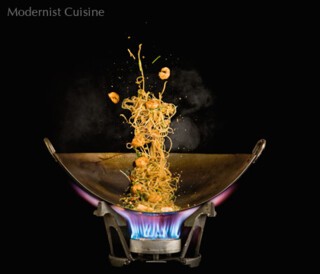Better Cooking through Chemistry
Jon Day
Nathan Myhrvold, who used to be Microsoft’s chief technology officer, has just published a £395, six-volume, 2400-page paean to the type of cooking sometimes known as ‘molecular gastronomy’. Modernist Cuisine is a luxurious and slightly self-congratulatory piece of work: a section of the accompanying website outlines every detail of the printing process (stochastic screening using Chroma Centric inks, if you’re interested); publication was delayed in order to redesign the slipcases, which had ‘failed a rigorous series of drop tests’. It’s full of amazing food-porn photographs of dishes being cooked, as well as essays on such topics as ‘Vaporisation and Condensation’ and ‘Sublimation and Deposition’.
Modernist Cuisine was written in response to that common problem, the lack of clear instructions for cooking ‘sous vide’. The technique involves vacuum-packing cuts of meat and immersing them in water at a carefully calibrated, relatively low temperature (around 60ºC) for a very long time. A burger takes 36 hours to cook and requires, as so many of these dishes seem to, liquid nitrogen. Centrifuges and rotor-stator homogenisers feature heavily.
The book brings to mind Marinetti’sFuturist Cookbook, which combined polemical attacks on pasta with demands for
the abolition of everyday mediocrity from the pleasures of the palate. We invite chemistry immediately to take on the task of providing the body with its necessary calories through equivalent nutrients provided free by the State, in powder pills, albumoid compounds, synthetic fats and vitamins.
Marinetti abolished knives and forks: you should eat with your left hand while stroking sandpaper and silk with your right. Between each course, aromas would ‘be driven from the table with the help of electric fans’. ‘Prescribed doses of poetry and music’ would ‘accentuate the flavours of a given dish with their sensual intensity’. ‘A battery of scientific instruments in the kitchen’ would be required to make ‘Sculpted Meat’, ‘Aerofood’ and ‘Chicken Virile’:
ozonisers to give liquids and foods the perfume of ozone, ultra-violet ray lamps (since many foods when irradiated with ultra-violet rays acquire active properties, become more assimilable, preventing rickets in young children etc.), electrolysers to decompose juices and extracts etc. in such a way as to obtain from a known product a new product with properties, colloidal mills to pulverise flours, dried fruits, drugs etc.: atmospheric and vacuum stills, centrifugal autoclaves, dialysers. The use of these appliances will have to be scientific, avoiding the typical error of cooking foods under steam pressure, which provokes the destruction of active substances (vitamins etc.) because of the high temperatures. Chemical indicators will take into account the acidity and alkalinity of the sauces and serve to correct possible errors: too little salt, too much vinegar, too much pepper or too much sugar.
Marinetti even opened a restaurant in Turin called the Taverna Santopalato (‘tavern of the holy palate’). His dishes never really took off, but he could hardly have expected them to: The Futurist Cookbook was a provocative joke. I wonder how seriously we should take Myhrvold et al?

Comments
'Hi, I've just put the oven on for dinner, so why don't you guys pop round tomorrow evening at about 7.23? It should be ready then. But please don't bring chilled drinks, open the freezer door or laugh too loudly when you arrive, as it may well disturb the equilibrium of the veal cutlets."